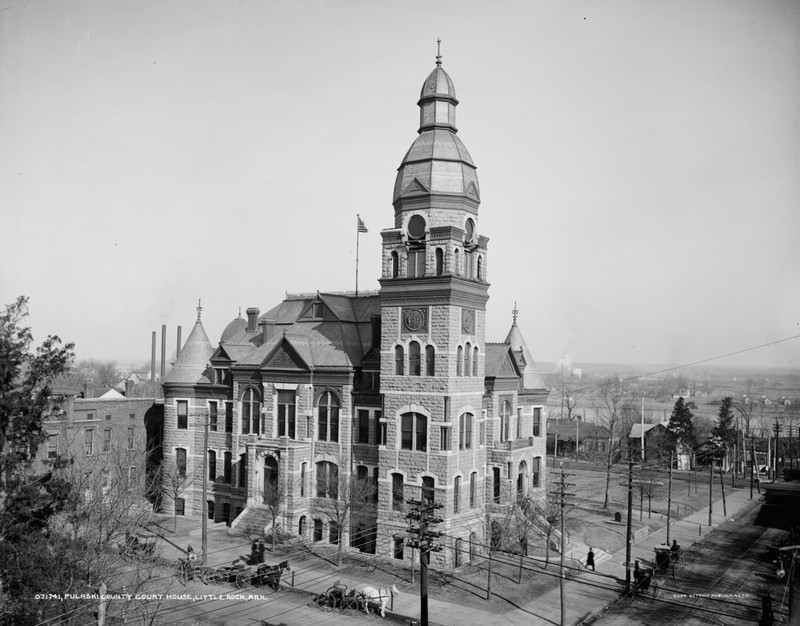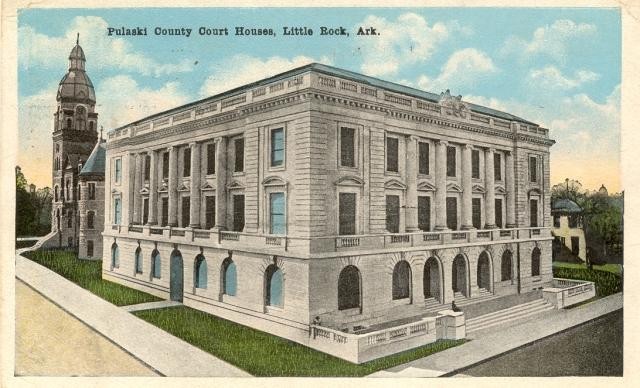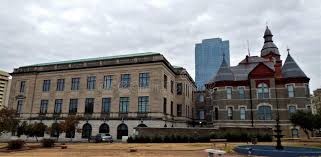Pulaski County Courthouse
Introduction
Text-to-speech Audio
The Pulaski County Courthouse complex includes two distinct buildings built decades apart with vastly different architectural styles. The first building on West Markham Street was built in 1914 utilizing the Beaux-Arts style of architecture. The second building was the original courthouse which was completed in 1889 in a Romanesque Revival subtype style called Richardson Romanesque. This 19th-century structure holds the offices of many officials who work at the courthouse. Preservationists have worked to maintain the historic integrity of these structures which serve as fine representations of these two architectural styles. And while many county courthouses were lost to time, the original building was the first permanent courthouse in Pulaski County.
Images
The first building of the Pulaski County Courthouse was specifically built with the intention for it to become one of the most premier buildings in Arkansas.

The second addition to the courthouse was built by a renowned architect, George R. Mann, who designed buildings all across the country and world.

The Pulaski County Courthouse building has undergone few changes throughout the years, and sits as a unique contrast amongst modern day skycrapers.

Backstory and Context
Text-to-speech Audio
When the Pulaski County Courthouse was completed in the late nineteenth century, it was the first of its kind in the area. While it was built during a time in which Pulaski County, specifically the Little Rock area, was growing. Years prior to the courthouse being completed the city introduced a water system in 1885, and the city’s first paved streets were laid down in 1887. The architect behind the first part of the courthouse was Max Orlopp Jr., who began designing it in 1886 a few years after he graduated from the U.S. Naval Academy. When he proposed his plan for the courthouse he had little to no experience in the field, but his design was so impressive that in 1887 construction began. Amazingly, almost all of the materials used to build the courthouse came from a mountain subdivision of the Ouachita Mountains, right in Arkansas.
In the decade following the completion of the courthouse, the population of Pulaski County had significantly grown, in fact, the population had risen by approximately forty percent. The sudden bouts of growth lead to many changes within the area. Such changes included the splitting of Little Rock into a second city named Argenta (now known as North Little Rock), and the move to expand the courthouse to accommodate the larger population. The designs for the second building of the Pulaski County Courthouse were drawn up in 1912, and construction began the following year. It was finished in 1914 and is a unique example of the Beaux-Arts style architecture which also features subtle hints of Classical style features like the Roman arches at the front of the building.
The impressive design of the Pulaski County Courthouse does not end on the outside of the building. Upon entering the 1914 part of the courthouse, now used as the main entrance area, the immaculate décor covering every inch of the inside is almost overwhelming to take in at one time. The entrance opens up into a large, center rotunda that is topped with a stained-glass dome. Directly underneath the dome are twelve statues designed and sculpted by Italian sculptor Giusto Liva and his two sons Paul and John Giusto. Each statue stands as a representation of various aspects deemed important to Arkansas: such aspects include agriculture, justice, and machinery. In addition to this, another aspect of the interior that contributes to the beauty is the sheer amount of marble that covers the walls and floors.
Architecture is an often overlooked aspect of historical significance when it comes to buildings and structures. However, it serves as a large part of any region’s history. The architecture of the Pulaski County Courthouse building is representative of Pulaski County’s and Little Rock’s short but rich history and its growth towards the largest city in the state. Additionally, the courthouse stands as a reminder of significant events that have taken place in Little Rock. The courthouse was one of the centers for the city manager system controversy during the early 1950s, and where same-sex marriage was first legalized in Arkansas in 2014. The city manager system of government controversy was directly tied to racial discrimination and problems throughout Little Rock in the mid-twentieth century. All of these problems would lead to the Pulaski County Grand Jury recommending passing a law that would make it illegal for police officers to join unions.
Sources
Besom, Robert, and Ethel Goodstein. "Pulaski County Courthouse." The Arkansas Historic Preservation Program. September 20 1979. http://www.arkansaspreservation.com/National-Register-Listings/PDF/PU3128.nr.pdf.
Blackwell, Elizabeth J. "Arkansas Listings in the National Register of Historic Places." The Arkansas Historical Quarterly 66, no. 4 (2007): 477-82. http://www.jstor.org/stable/40031126.
Craig, Jared. Pulaski County Courthouse , Encyclopedia of Arkansas . September 15th 2020. https://encyclopediaofarkansas.net/entries/pulaski-county-courthouse-9220/.
Pierce, Michael. "The City Manager System and the Collapse of Racial Moderation in Little Rock, 1955-1957." The Arkansas Historical Quarterly 78, no. 2 (2019): 166-205. doi:10.2307/26794568.
https://www.google.com/url?sa=i&url=https%3A%2F%2Fsah-archipedia.org%2Fbuildings%2FAR-01-PU7&psig=AOvVaw11dOlGszYPPEhy9Y_h4Kvv&ust=1606771737430000&source=images&cd=vfe&ved=2ahUKEwjQ17am2ajtAhUjja0KHTlXBbwQr4kDegUIARDcAQ
https://www.google.com/url?sa=i&url=http%3A%2F%2Fcourthousehistory.com%2Fgallery%2Fstates%2Farkansas%2Fcounties%2Fpulaski&psig=AOvVaw11dOlGszYPPEhy9Y_h4Kvv&ust=1606771737430000&source=images&cd=vfe&ved=2ahUKEwjQ17am2ajtAhUjja0KHTlXBbwQr4kDegUIARD6AQ
https://www.google.com/url?sa=i&url=https%3A%2F%2Fwww.dreamstime.com%2Fpulaski-county-arkansas-little-rock-goverment-constructed-historic-courthouse-downtown-joined-nearby-bankruptcy-court-image152073993&psig=AOvVaw0ONPkqrkpN16_3UXAk33l8&ust=1606771438095000&source=images&cd=vfe&ved=2ahUKEwjV3diX2KjtAhVCe6wKHf_xCLkQr4kDegUIARDRAQ
